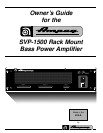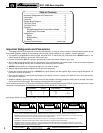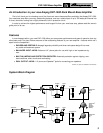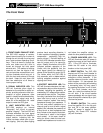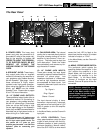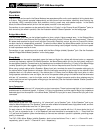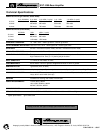
SVP-1500 Bass Amplifier
6
Operation
Stereo Mode:
The SVP-1500 can be used in the Stereo Mode as two separate amplifier units, each capable of driving loads down
to 2 ohms. Each channel operates independently and has its own input connectors, sensitivity level controls, sig-
nal indicator LEDS, automatic limiter, fault protection circuitry, power amp, and speaker outputs. In the Stereo
Mode, the Mono/Stereo switch (#14 on the rear panel) must be in the OUT position.
Connections to your speakers can be made with either the 1/4” jacks* or the Channel A and B Speakon
®
jacks (or
both since they are wired in parallel). See the illustration labeled “Stereo Operation” on the facing page.
Bridged Mono Mode:
The two power amplifiers can be bridged together to form a single, higher-powered amp. In the Bridged Mono
Mode, the amplifier uses Channel A's input jacks and Sensitivity control; Channel B's are disconnected. Channel
B's power amp receives its signal from a tap after Channel A's Sensitivity control, but prior to Channel B's Limiter,
so each channel is independently protected. To select the Mono Mode, the Mono/Stereo switch (#14 on the rear
panel) must be in the IN position. Because both channels are being used (bridged in series), the minimum speak-
er load impedance must be 4 ohms.
Connections to your speakers must be made with the Mono Bridge (middle) Speakon
®
jack. See the illustration
labeled “Bridged Mono Mode Operation” on the facing page.
Biamp Mode:
The SVP-1500 can be used to separately power the lows and highs of a cabinet with biamp inputs or a separate
low and high frequency cabinet. For Biamp Operation, the Mono/Stereo switch (#14 on the rear panel) must be in
the OUT (stereo) position. Connections to your speakers can be made with either the 1/4” jacks* of the Mono Bridge
(middle) Speakon
®
jack. We suggest using Channel A for the low frequencies and Channel B for the highs.
When using a single cabinet with a Speakon
®
Biamp Input jack, terminate the end of the speaker cable going to
the cabinet with a single Speakon
®
connector. (Wire the connector according to the pinouts on the cabinet’s input
jackplate label or in its owners manual). If the cabinet has 1/4” Biamp Low and Biamp High Input jacks, or when
using separate cabinets for lows and highs, the end of the speaker cable going to the cabinet must be terminated
with two 1/4” connectors – one for the highs, one for the lows. (A pigtail connector and/or other adapters may be
used to split the low and high speaker wires going to the cabinets.) See the illustration labeled “Stereo Operation”
on the facing page.
Input Connectors:
The SVP-1500 uses balanced 1/4" phone jacks as input connectors. These inputs accept High or Low impedance
and balanced or unbalanced signals. A "stereo" 1/4" plug (ring/tip/sleeve) must be used to feed a high impedance
balanced signal into the amplifier. In the Mono Mode, Channel A’s input jack is used; Channel B's input jack is dis-
connected.
Speaker Output Connectors:
Each channel of the SVP-1500 has both a 1/4" phone jack* and a Speakon
®
jack. A third Speakon
®
jack is pro-
vided for Mono Bridged use. The Speakon
®
jacks are more reliable for extended use at high power levels, and their
use is always recommended over the 1/4” phone jacks.
On each channel, the Channel A and B Speakon
®
jacks are wired in parallel with the 1/4" phone jacks: the tip of
the 1/4" jack is connected to pin 1+ of the Speakon
®
jack and the sleeve is connected to pin 1–. Use of both the
1/4" jack and the Speakon
®
jacks simultaneously to connect two cabinets in parallel is possible, providing proper
polarity is observed.
The SVP-1500’s Mono Bridge (middle) Speakon
®
jack is wired as follows: Pins 1+ and 1– = Channel B+ and –
respectively; pins 2+ and 2– = Channel A + and – respectively.
*NOTE: 1/4” jacks not available in some areas.



